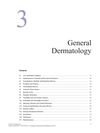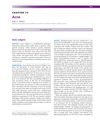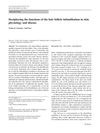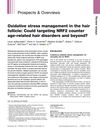Chloracne: Histopathologic Findings in One Case
April 2002
in “
Journal of cutaneous pathology
”
chloracne vellus hair follicle infundibula keratotic plugs orthokeratotic basket-weave basophilic corneocytes eosinophilic laminated sebum granular sebum infundibular cysts comedones sebaceous glands squamous metaplasia hyperpigmentation melanin production melanocytes basal layer infundibular epithelium melanin granules corneocytes hair follicle skin cysts blackheads oil glands skin pigmentation skin cells
TLDR Tiny infundibular cysts are the main lesions in chloracne, not comedones.
The study examined a patient with severe chloracne, focusing on the histopathologic characteristics of facial lesions. The findings revealed that nearly every vellus hair follicle was affected, showing dilated infundibula filled with keratotic plugs composed mainly of orthokeratotic basket-weave basophilic corneocytes. Some infundibula also contained eosinophilic laminated or granular sebum. Small infundibular cysts were more prevalent than comedones, and mature sebaceous glands were present at the base of many dilated infundibula without squamous metaplasia. Hyperpigmentation was due to increased melanin production by melanocytes in the basal layer and infundibular epithelium, with melanin granules also found in the corneocytes of the plugs. The study concluded that tiny infundibular cysts, rather than comedones, are the primary lesions in chloracne.




